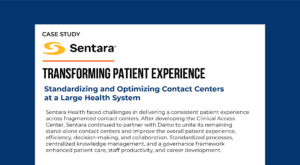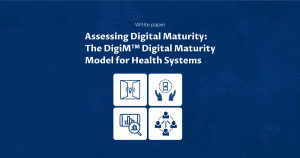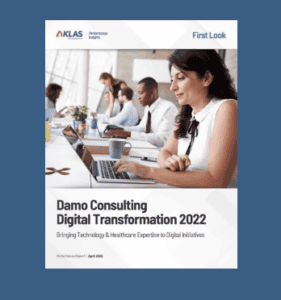COVID-19 is showing how efficient video visits can be for healthcare
– Seth Hain, Senior VP of R&D and Dr. Sam Butler, Leader of Clinical Informatics at Epic
Our recent podcast guests on The Big Unlock podcast were Seth Hain, Senior VP of R&D and Dr. Sam Butler, Leader of Clinical Informatics of Epic. They discuss how emerging technologies like telehealth, video visits, and other virtual care platforms will become an integral part of healthcare in future and how the current COVID-19 pandemic is proving the importance of technology in conversation with Paddy Padmanabhan, CEO of Damo Consulting on the Big Unlock Podcast.
Listen to the full conversation
“As this pandemic started to hit, we rapidly released a series of capabilities for healthcare organizations to evaluate and understand our deterioration index model in the context of COVID-19 positive patients, as well as guidance on workflows to use it in that context and it’s been an interesting set of conversations where they have quickly evaluated how the model performs and deeply understood the impact and value of it in their workflow and have been implementing it across. Over 50 organizations are using the model at this point.” – Seth Hain, The Big Unlock podcast
Video visits are here to stay
Dr. Sam Butler talks about how the current COVID-19 pandemic is showing the effectiveness of virtual care technologies in healthcare. The current pandemic has changed the way healthcare is being delivered, physicians are now allowed to do video visits with patients and bill them with standard office visits. Epic saw around 2.5 million video visits in April alone.
“I think that we are going to see video visits as an integral part of healthcare from now on. And it took this pandemic to really show how efficient and useful a video visit can be. I did pulmonary and critical care before joining Epic and for every visit patients had to come every three months, a family member would have to get off work, get them in a car, get their oxygen set up, get them into the clinic, get them into my exam room, which typically needed some furniture rearrangement to fit the oxygen and the wheelchair. All this for a 10-minute visit with the patient. I used to think back then, what a waste for the whole system. Many times, I could have done that visit as a video visit.” – Dr. Sam Butler, The Big Unlock podcast
In addition to the increase in virtual care platforms, there is an increase in home monitoring devices as well. Such devices are not only convenient to patients but is also preventing exposure of providers and clinicians who are on the front line during this pandemic.
“We’re also seeing an increase in the number of home monitoring devices that are available. So this is sort of coming on the back of a series of changes in technology that make it more viable for the individual to stay in the comfort of their own home and understand things like their pulse ox as part of a visit and provide that to their provider. Both provide convenience for the patient and in some cases help to not expose the providers and clinicians and folks on the front line as well. So, there’s a variety of positives that we’re seeing start to emerge on top of this.” – Seth Hain, The Big Unlock podcast
State of digital transformation in wake of COVID-19
Seth observes that they are seeing a solid base of both critical infrastructure and a foundation across health systems and says that there is rapid innovation in a variety of spaces, on the technology front as well as with regards to their operations.
“One of the keys that we have seen is that by having a solid base of both a kind of critical infrastructure and a foundation across the health system, as well as things like MyChart in patients hands, healthcare organizations have been able to rapidly innovate in a variety of spaces, both on the technology front as well as in regards to their operations. Like Cleveland Clinics’ rapid deployment of MyChart Care Companion, the use of the Deterioration index model for COVID and the rapid rollouts of telehealth where organizations have changed their practice. But in addition to that, they’ve also updated their operations and continue to roll out in new ways.” – Seth Hain
In context of the technology, Seth states that technologies like contact tracing platform will not only be driven by a broader adoption but needs to be augmented to fully account for the whole population.
“The effectiveness of contact tracing is really driven by broad adoption. And I think that in the context of some of the technologies that are being discussed today, there are reasonable considerations that might limit that adoption in certain contexts. Both privacy as an example for some of the technologies that track and understand what individuals have come in contact with others as well as limitations in regard to the use of those technologies in certain communities and certain populations. And because of that, we see this as one piece of the puzzle in understanding and tracking the spread of disease across the community and helping understand who may need to self-isolate, for example. But it needs to be augmented with other capabilities, both technology as well as kind of good old-fashioned folks reaching out to others to make sure that they’re taking care of themselves and their loved ones and isolating where appropriate. So, we certainly see it as part of the puzzle, but it needs to be augmented to fully account for the whole population.” – Seth Hain
The new normal after COVID-19
Seth and Sam believe that healthcare industry will adopt and leverage new emerging technologies in future. Virtual care platforms such as telehealth and video visits allow rapid and quick care for patients and are already showing its efficiency in the current pandemic.
“I think the future physician schedule will be 50 percent face-to-face visits and 50 percent non-face-to-face through video, telephone, and an asynchronous electronic visit back and forth. I think that’s going to be the norm and it’ll be associated with appropriate reimbursement so we can continue to do that.” – Dr. Sam Butler
“In addition to that, patient and provider approach to new technologies with telehealth, we will see organizations building out and continuing to enhance their foundational platforms to be able to adapt to the workflow.” – Seth Hain














